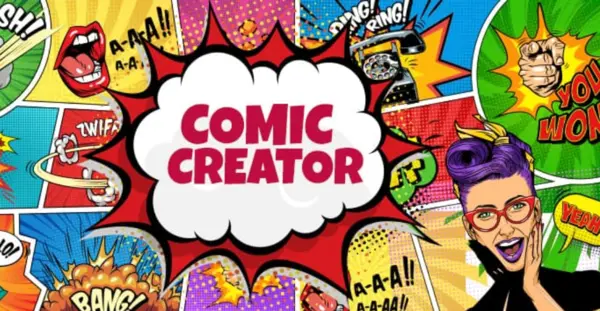The art of storytelling has found new life in the form of comics, a medium that blends visuals and narrative to captivate audiences. Thanks to technology, creating comics is no longer restricted to professional artists or studios. Enter comic creators—digital tools designed to help anyone craft compelling comics. Whether you’re a beginner or a seasoned storyteller, this article delves into actionable strategies, tips, and insights to make the most of comic creator tools.
What Is a Comic Creator?
A comic creator is a software or platform that enables users to design, illustrate, and publish comics. These tools often come equipped with drag-and-drop features, pre-designed templates, and various customization options to simplify the creative process.
How Do They Work?
Comic creators streamline the comic-making process by offering:
- Templates: Pre-made layouts for panels, text bubbles, and backgrounds.
- Illustration Tools: Brushes, shapes, and color palettes for custom artwork.
- Asset Libraries: Access to characters, props, and scenes for quick assembly.
- Publishing Options: Exporting comics in formats suitable for digital or print distribution.
“Comic creators empower storytellers to bring their ideas to life, regardless of artistic skills.” — Jane Doe, Graphic Novelist
Benefits of Using Comic Creators
- Accessibility: Create comics without advanced drawing skills.
- Cost-Effective: Many tools offer free versions or affordable subscriptions.
- Speed: Accelerate the creative process with ready-made assets.
- Versatility: Adaptable for various genres, styles, and audiences.
- Collaboration: Work with teams remotely using cloud-based tools.
Practical Applications
- Personal Projects: Share your stories with friends or publish independently.
- Education: Teach concepts through engaging visual narratives.
- Marketing: Craft promotional materials with an artistic twist.
- Entertainment: Create webcomics or graphic novels for wide audiences.
Popular Comic Creator Tools
Here’s a look at some leading comic creator platforms:
| Tool Name | Key Features | Pricing | Use Case |
| Canva | Drag-and-drop design, templates | Free and paid plans | Beginners, Marketing |
| Pixton | Customizable characters, education focus | Free and subscription-based | Teachers, students |
| Clip Studio Paint | Professional-grade illustration tools | Paid | Professional artists |
| Comic Draw | Intuitive comic creation app | Paid | Independent creators |
| MediBang Paint | Cloud-based platform, collaborative | Free and paid plans | Collaborative projects |
Technology has democratized comic creation, enabling stories to reach a global audience.” — John Smith, Digital Artist
How to Get Started with a Comic Creator
Step 1: Choose the Right Tool
Select a comic creator based on your needs:
- Beginners: Canva or Pixton for simplicity.
- Advanced Users: Clip Studio Paint for detailed illustrations.
Step 2: Plan Your Story
Outline your comic’s narrative, characters, and key scenes. Consider:
- Theme: Define the overarching message or genre.
- Characters: Create profiles for your protagonists and antagonists.
- Plot: Develop a beginning, middle, and end.
Step 3: Design the Layout
Use templates or create custom layouts to organize panels and text bubbles. Ensure:
- Clarity: Each panel conveys a clear idea.
- Flow: The sequence guides readers seamlessly through the story.
Step 4: Illustrate or Use Assets
Leverage built-in libraries or draw your own characters and backgrounds. Experiment with:
- Styles: Cartoonish, realistic, or experimental.
- Colors: Set the mood with appropriate palettes.
Step 5: Add Dialogue and Effects
Integrate text bubbles, captions, and sound effects. Use:
- Readable Fonts: Ensure clarity and style alignment.
- Sound Effects: Enhance action scenes with onomatopoeia.
Step 6: Export and Share
Finalize your comic and export it in your preferred format for digital or print distribution.
Tips for Creating Engaging Comics
- Focus on Storytelling: A strong narrative keeps readers hooked.
- Experiment with Panel Sizes: Use varied layouts to emphasize key moments.
- Pay Attention to Expressions: Characters’ emotions should resonate with readers.
- Use Contrast: Highlight important elements with contrasting colors or designs.
- Seek Feedback: Share drafts with peers for constructive criticism.
Challenges and Limitations
While comic creators simplify the process, challenges include:
- Limited Customization: Free versions may lack advanced features.
- Learning Curve: Mastering tools takes time.
- Generic Assets: Overuse of templates can make comics look less unique.
“The best comics are those that balance visuals and storytelling to create unforgettable experiences.” — Emily Carter, Comic Writer
Future of Comic Creators
The evolution of comic creators promises exciting advancements, such as:
- AI-Assisted Design: Automated character generation and scene suggestions.
- Interactive Comics: Integration of animations and sound effects.
- Enhanced Collaboration: Real-time teamwork features for global creators.
FAQ: Comic Creators
1. Can I sell comics made with a comic creator?
Yes, most platforms allow you to commercialize your creations. Check the tool’s licensing terms.
2. Do I need drawing skills to use a comic creator?
No, many tools provide pre-designed assets to simplify the process.
3. Are there free comic creators available?
Yes, platforms like Canva and MediBang Paint offer free versions.
4. What genres can I explore with comic creators?
You can create comics in any genre, including action, romance, fantasy, and more.
5. How do I publish my comic?
Export your comic in a digital format (e.g., PDF, JPEG) or print it through publishing services.
Comic creators have redefined how stories are told, offering unparalleled opportunities for creativity and expression. Whether crafting a webcomic, teaching through visuals, or pursuing a lifelong dream of publishing a graphic novel, these tools empower you to bring your vision to life. Start your journey today and let your imagination take the lead!
